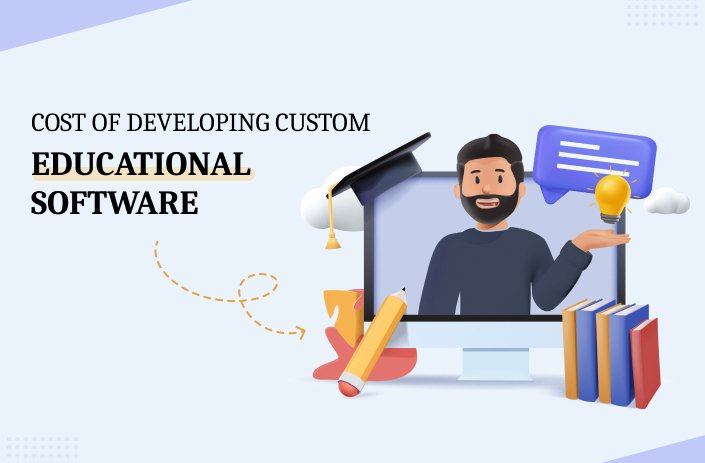

Learning online has become quite a norm after the recent Pandemic. In fact, institutes are investing quite heavily in this domain of educational software development to ensure learning remains engaging, fun and easy to manage. This demand estimates that the market of edtech software is supposed to cross $404 billion by 2025, and the metaverse education sector alone is expected to be worth $3.6 billion. How good is that?
This means that there has never been a larger demand for elearning software and custom software development. The widespread use of AI, mobile learning, and immersive technologies is driving this growth. These technologies are changing the way students and teachers use digital platforms in a big way.
Key Stats Shaping the Industry
Before moving ahead and digging in deep in the field of educational software development, let’s address the numbers that shows the impact of it already.
- The global market for AI in education is expected to expand from $2.1 billion in 2024 to $5.8 billion by 2030.
- By the end of 2025, more than 70% of schools are projected to use immersive technology like AR and VR.
- The game-based learning business is expected to be worth $7.5 billion by 2025. This shows how important it is to keep people interested through gamification.
Educational Software Development: All You Must Know
The process of creating, building, and maintaining digital tools that make learning and teaching better is called educational software development. These options include AI-driven tutoring platforms, gamified apps, learning management systems (LMS), and elearning software.
Types of Educational Software
Some of the popular for educational software that you can consider following are:
- Learning Management Systems (LMS): Tools like Google Classroom and Moodle for keeping track of tests and classes.
- Online course providers: Coursera and Udemy and virtual classrooms are examples of elearning platforms.
- Games and simulations for learning: interactive tools that get kids to learn by playing.
- AI-Based Learning Apps: Personalized learning tools like Duolingo and Khan Academy.
- Assessment Tools: Programs for quizzes, tests, and evaluations.
Top Trends in EdTech Software Development for 2025
There are a few important trends that are changing the education field. Any company that makes educational apps needs to think about these while deciding how to make educational software.

- Artificial Intelligence and Personalization: AI-powered platforms look at student data to create personalized learning experiences by changing the content to fit each student’s needs and speed of learning. This level of customization makes people more interested and improves results, which is why AI integration is a key part of edTech software development.
- Extended Reality (XR): AR & VR Integration: AR and VR make learning more fun and interactive by putting you in real-life situations. XR technologies are making learning more dynamic and accessible, from virtual science laboratories to recreations of historical events. The metaverse is also offering up new ways for people to connect and work together.
- Microlearning and Gamification: Microlearning breaks down hard subjects into smaller parts, while gamification adds things like badges, leaderboards, and interactive challenges. These methods help students remember what they learned and stay motivated, especially Gen Z students who like quick, interesting content..
- Mobile-First Learning: Mobile-first education app development makes ensuring that content is always available on mobile devices, which are becoming the main way many students access information. Responsive design and the ability to work offline are two important features of modern elearning software.
- Hybrid and Remote Learning: The move toward hybrid models, which mix in-person and online learning, calls for strong, flexible educational software that works for both synchronous and asynchronous learning.
- Social and Emotional Learning (SEL): Adding SEL features lets teachers keep an eye on and help students with their emotional health, which makes learning spaces more welcoming and flexible.
Read More: How Enterprise Software Transforms Large-Scale Businesses in Kuwait?
The Step-by-Step Process: How to Develop Educational Software?
To make educational software that works well, you need to think about the big picture and put the user first. Here is a whole plan:

1. Define Your Vision and Target Audience
Begin by figuring out what educational problem your software will solve. Is it for K–12, college, or business training? To make unique software that works, you need to know what your audience needs.
2. Market Research and Competitor Analysis
- Look at the solutions that are already in place and find any holes.
- Look at user reviews and comments to uncover problems.
- Compare the features and prices of the best competitors.
3. Choose the Right Technology Stack
Choose technology that can grow, are safe, and can work with other tools. Cloud-native platforms, AI/ML frameworks, and AR/VR development kits are some of the most popular stacks.
4. Design User-Centric Interfaces
- Give priority to easy navigation and access.
- Use responsive design to make sure that both mobile and desktop users have a smooth experience.
- Add elements that make it easier for students with impairments to learn.
5. Develop Core Features
Important attributes of modern elearning software are:
- Profiles and registration for users
- Making and running courses
- Content components that let you interact with them, like films, quizzes, and simulations
- Chat and discussion boards that happen in real time
- Keeping track of progress and analyzing it
- Leaderboards and badges are examples of gamification components.
- Connecting to other tools, such LMS and payment gateways
- Personalization and suggestions based on AI.
6. Implement Security and Data Privacy
Make sure you follow the rules for protecting data (GDPR, FERPA). To protect user data, utilize encryption, secure authentication, and frequent security audits.
7. Testing and Quality Assurance
- Test usability with real people.
- Do tests for functionality, performance, and security.
- Use feedback to improve the user experience by iterating.
8. Launch and Ongoing Support
Put your app on a cloud infrastructure that you can trust. To keep people interested and meet their demands, provide onboarding resources, user support, and regular updates.
Challenges in Educational Software Development
Even though technology has come a long way, there are still several problems with making edtech software:
- Access to All: Designing for everyone, even people with disabilities.
- Data Privacy: Following complicated rules and keeping users’ trust.
- Content Quality: Finding the right balance between interesting multimedia and strict educational standards.
- User Engagement: Keeping people interested by making things fun and personal.
- Scalability: The ability to handle more users without slowing down.
To solve these problems, we need a mix of technical knowledge, teaching experience, and input from users.
Why Work with an Education App Development Company?
Working with a prominent educational app development company can help you with several benefits:
- Industry Expertise: A thorough awareness of educational trends and rules.
- Custom Solutions: Features that are made just for your learning needs.
- Faster Time-to-Market: Processes that are easier to follow and frameworks that can be used again.
- Ongoing support: Planning for maintenance, updates, and growth.
This relationship is especially useful for groups that are new to making instructional software or that want to come up with fresh ideas quickly. This is where LL Technolab can help you out. We have all the boxes ticked for your needs of an education app development company.
SEO Best Practices for EdTech Software Development
In the congested EdTech sector, being seen is really important. To make sure your e-learning software stands out, do the following:
- Keyword Optimization: Focus on phrases with high intent, such as “custom software development for easy learning management”.
- Mobile Optimization: Make sure your site is fast and responsive for mobile-first indexing.
- Content Marketing: Write useful blogs, guides, and case studies to get organic traffic.
- Technical SEO: Speed up your site, use structured data, and make sure your architecture is secure and crawlable.
- Personalization: Use AI-driven content recommendations to increase engagement and retention.
Costing Of Educational Software Development
The cost to develop educational software can be very different depending on how complicated it is, what features it has, and what technological stack it uses. Here are the primary things that affect the cost:
- Basic educational apps: $20,000–$35,000
- Mid-level platforms (with AI, gamification): $40,000–$80,000
- Advanced solutions (AR/VR, real-time analytics, large-scale LMS): $90,000–$150,000+
Factors Influencing Cost:
- How many features and how hard they are
- Working with services from other companies
- Designing a custom user interface and experience
- Requirements for security and compliance
- Updates and maintenance regularly
Working with an experienced company like LL Technolab that makes education apps can help you get the best results at the lowest cost.
The Future of Educational Software Development
Continuous innovation is what will shape the future of educational software development. AI, XR, microlearning, and data-driven personalization will all be important parts of the next generation of e-learning software. As the field grows, the investment of making educational software will be worth it since it will lead to better learning outcomes, more access, and more engagement.
Organizations may make useful, future-ready educational solutions by staying ahead of trends, concentrating on what users need, and getting help from an education app development business.
Final Take
Hopefully, you have got complete clarity on how to proceed ahead with educational software development and in the time to come. In fact, it is all about enhancing learning experiences that are more fun, engaging, and easy for all to be part of in their growth journey. So, if you are thinking about making an investment in the edTech world, then we is here to help you with complete education software development services. Consult now and get your customized solution for your educational transformation.

